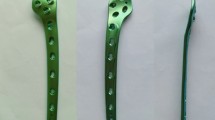Abstract
Three female patients over 70 years of age were treated surgically for a pertrochanteric fracture of the hip. In 2 of them internal fixation was achieved by way of a dynamic screw-plate assembly while intramedullary Ender nails were used in the 3rd patient. All 3 patients were readmitted a couple of months after discharge from hospital due to a new subcapital fracture that occurred ipsilaterally through the tip of the fixation device after the primary pertrochanteric fracture had already reached a solid union. None of these cases resulted from inadequate placement of the fixation device: 1. The neck-shaft angle had been correctly restored. 2. The metals were centrally positioned in the femoral head and neck as documented in both the AP and axial views. 3. The distance between the subchondral bone and the tip of the device was consistently less than 10 mm. Neither X-rays nor histology showed any evidence of AVN or other pathologic processes (other than osteoporosis).
This rare complication which requires immediate reoperation with removal of the metals and some form of arthroplasty of the hip joint has been reported 27 times following different types of internal fixation methods. The etiology of these interesting cases is still unclear and multiple theories have been proposed to explain this phenomenon. Among these the most popular is that of a technical error consisting of inserting the nail not deeply enough into the subchondral bone thus exposing the cancellous femoral neck to strong forces that tend to deform the femoral head into a varus position, with the metallic tip acting as a stress riser. Our own observations hereby presented challenge this theory as we have found no evidence to support it. The fact that perfect positioning of the device is not enough to guarantee a successful outcome raises the issue of whether it is justified to consider a second operative intervention for early removal of the metals as a preventive measure.
Similar content being viewed by others
References
An H, Wojcieszek JM, Cooke RF, et al. Simultaneous ipsilateral intertrochanteric and subcapital fracture of the hip. Orthopedics 1989;12:721–3.
Baker DM. Fractures of the femoral neck after healed intertrochanteric fractures. J Trauma 1975;15:73–81.
Bonamo JJ, Accettola AB. Treatment of intertrochanteric fractures with a sliding nail-plate. J Trauma 1982;22:205–15.
Cameron HU, Pilliar RM, Hastings DE, et al. Iatrogenic sub-capital fracture of the hip. CORR 1975;112:218–20.
Chan KM, Tse PYT. Late subcapital fracture of the neck of the femur — a rare complication of Ender nailing. J Trauma 1986;26:196–8.
Doppelt SH. The sliding compression screw - today's best answer for stabilization of intertrochanteric hip fractures. Orthop Clin North Am 1980;11:507–23.
Enneking WF. Clinical musculoskeletal pathology. Florida: Storter, 1986:139.
Fairbank AC, Ellis M, Jinnah RH. Spontaneous subcapital femoral neck fracture complicating a healed pertrochanteric fracture. Injury 1993;24:692–4.
Gogan WJ, Daum WJ, Simmons DJ, et al. Subcapital fracture of the hip following an intertrochanteric fracture. CORR 1988;232:205–9.
Hardy D, Lafontaine M, Stelmaszyk J, et al. Subcapital fracture of the femoral neck — a rare complication of a pertrochanteric fracture healed in coxa vara position. Acta Orthop Belg 1990;56:507–11.
Hunter GA, Mehta A. Subcapital fracture of the hip — a rare complication of intertrochanteric fracture of the femur. Can J Surg 1977;20:165–72.
Lombardi LJ, Cleri DJ, Goldhagen PR, et al. Subcapital fracture complicating fixation of an intertrochanteric fracture from osteomyelitis. Orthop Rev 1994;23:257–60.
Malkani AL, Rand AJ. Subcapital femoral neck fracture following open reduction and internal fixation of an intertrochanteric hip fracture using a sliding screw and side plate. Orthop Rev 1993;22:469–72.
Mariani EM, Rand JA. Subcapital fractures after open reduction and internal fixation of intertrochanteric fractures of the hip. CORR 1989;245:165–8.
Marshall JH, Brooks JP. A second proximal femoral fracture caused by failure of a sliding hip screw. Injury 1993;24:694–5.
Parker MJ, Walsh ME. Importance of sliding screw position in trochanteric fracture. Acta Orthop Scand 1993;64:73–4.
Ross PM, Kurtz N. Subcapital fracture subsequent to Zickel nail fixation. CORR 1980;147:131–3.
Tronzo RG. Surgery of the hip joint. Philadelphia: Lea & Febiger, 1973:526.
Wilson-McDonald J. Subcapital fracture complicating an intertrochanteric fracture. CORR 1985;201:147–50.
Author information
Authors and Affiliations
Rights and permissions
About this article
Cite this article
Cohen, I., Rzetelny, V. Subcapital fractures complicating pertrochanteric fractures treated by internal fixation. Unfallchirurgie 25, 33–38 (1999). https://doi.org/10.1007/BF00578961
Issue Date:
DOI: https://doi.org/10.1007/BF00578961




